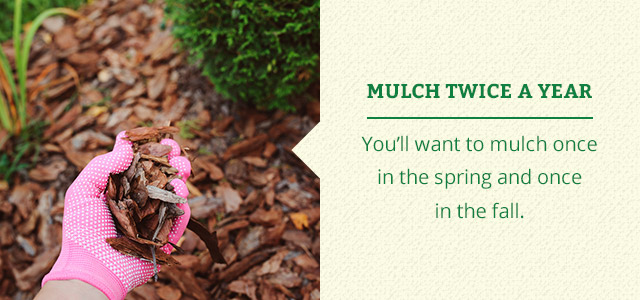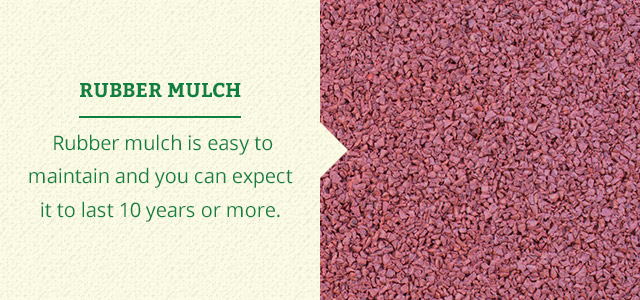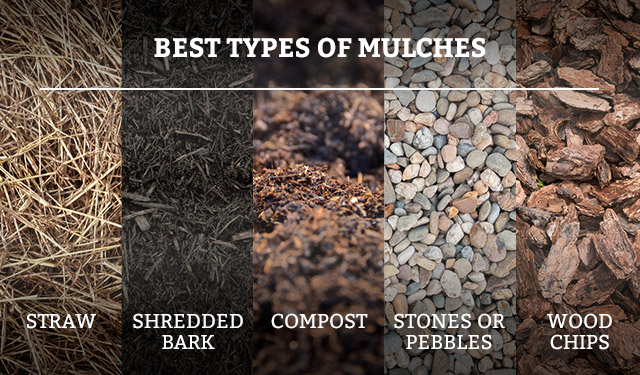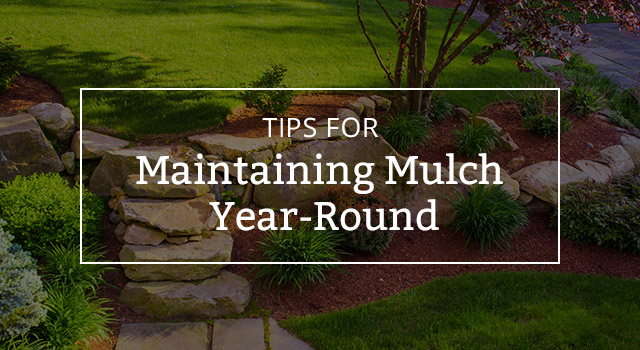Mulch can make a landscape pop with color and create an appealing, polished look. Mulch also helps plants stay healthy and keep them growing strong. There are a multitude of benefits to include mulch and soil into your yard. Mulch:
- Provides insulation, keeping roots warm in the winter and cool in the summer
- Helps the soil retain moisture
- Improves soil nutrition
- Protects soil from erosion and compaction
- Discourages weed growth
- Helps protect plants from lawn mower damage
Best of all, mulch takes care of your plants without asking for much in return. With that said, there are a few tips and tricks to keep mulch looking fresh and vibrant, regardless of weather conditions. In this post, we’ll show you how to care for mulch year-round, so your garden will withstand cold winter days and be ready to bloom in the spring.
How to Maintain Mulch
Generally, mulch needs very little attention to function as it should, and some mulches can last 10 years or longer before needing to be replaced. It’s most important to occasionally check the depth of your mulch and make sure it falls between 2 to 4 inches deep. Nevertheless, mulch color naturally fades over time from sun exposure, and sometimes weeds rear their tiny heads no matter what you do. Here are top tips to care for your mulch year-round — you’ll have lots of time leftover to relax and enjoy your garden!
1. Refresh Mulch Color
Over time, mulch colors fade due to frequent exposure to sunlight. Regular non-dyed mulch may become a grayish color in one to two months, while dyed brown or black mulches may keep their color for a year or longer. Eventually, all mulches will fade without maintenance. So, what’s the trick to brightening pale mulch?
The easiest way to take care of faded mulch is to add a thin layer, or an inch or less, of fresh mulch to cover up the gray mulch. However, before adding new mulch to old layers, examine the existing mulch. How deep are the old layers? How long has it been since you’ve replaced mulch? Is the mulch soggy or decomposing?
If the old mulch is rotting, it’s time to replace it altogether. Otherwise, try to remove as much mulch as you can before adding a new layer, because you do not want too many layers as this could kill your plants. When mulch layers build up beyond 4 inches, they become water-repellent, or hydrophobic. Too much mulch can also suffocate plant roots. When you have the old mulch layers down to an inch or two, it’s safe to add an inch or two of fresh, colorful mulch.
2. Remove Weeds
Despite mulch’s amazing ability to ward off weeds, they still manage to emerge now and then. Fortunately, there are ways to keep even the peskiest weeds under control.
First, if you notice weeds growing from your mulch, you may need to add more mulch. Try to keep mulch layers at least 2 inches deep to block sunlight and keep weeds from growing. Mulch must block sunlight to prevent weed growth. Choose coarse chipped or shredded bark mulches because they decompose slowly and are less likely to blow away.
Second, make sure to pull weeds by hand as soon as you see them before they take over. A single weed can produce thousands of seeds in a season. Weeds compete with neighboring plants for water, sunlight and nutrients, so try to remove weeds when they are small before seeds form.
You could apply a pre-emergence herbicide to prevent germinating weed seeds. However, pre-emergence herbicides do not control weeds that have already sprouted. To apply a pre-emergence herbicide, rake the mulch away, pull any existing weeds and apply the product following the instructions on the package. You can also try corn gluten meal as an organic alternative. Replace the mulch after applying the pre-emergence herbicide.
For existing weeds, you can use a post-emergence herbicide spray. Organic options include vinegar or clove oil sprays. Be careful not to harm nearby plants, and speak with a nursery to choose the right herbicides for your needs.
If you have not yet added mulch or are in the process of replacing mulch, you can skip herbicide altogether and instead install landscape fabric to keep weeds from growing.
3. Mix and Turn Mulch
Every season, you’ll want to mix and turn your mulch a couple of times to break up clustered pieces and make sure it hasn’t formed a compacted layer on top of the soil. To turn the mulch, grab your rake and gloves and take the following easy steps:
- Rake the beds, breaking up clumps
- If needed, spread new mulch over the bed, so it’s no more than 2 to 4 inches thick
- Make sure mulch is a few inches away from plant stems and tree trunks to prevent plant damage
- Rake or turn over with your hands a few times a season
- As mulch decomposes, add fresh mulch to keep the layer at 2 to 4 inches
4. Mulch Twice a Year

You should add mulch whenever layers thin out for any reason. You’ll also want to replace mulch if it breaks apart in your hands like dirt because it’s no longer effective at that point. Otherwise, you’ll want to add mulch twice a year — once in the spring and once in the fall.
In the spring, add more mulch to either replace old decomposed mulch or to replenish mulch that has washed or blown away, making sure to maintain a thickness of at least 2 inches. Wait until mid to late spring when the soil is warm and moist to apply new mulch to keep moisture in and help prepare plants for summer heat. If you add mulch too early or when the soil is cool and wet, it could slow seed germination.
In the fall, apply fresh mulch to insulate plants and protect roots from harsh winter temperatures. Wait until after the first freeze to apply mulch, but add mulch before temperatures get too cold. If you add mulch before the ground freezes, you might attract critters looking for a winter home. Choose loose material like straw, hay or pine boughs to insulate plants without compacting under snow. By adding mulch in the fall, you help reduce the freezing and thawing process which, in turn, reduces the risk of plant injury.
Also, regardless of the season, always mulch around new plants right after you plant them for the best results.
5. Keep Mulch From Washing Away
If you’ve stepped outside to find mulch tossed all over the yard, you’re not alone. Sometimes, even the toughest mulch can’t stand up to strong gusts of wind or torrential downpours. There are all kinds or reasons mulch layers thin out over time, and they need to be replaced to protect nearby plants and trees effectively, deter weed growth and keep your garden looking great. Here are tips to help make your mulch stay put:
- Choose the right mulch: Heavier mulches, like hardwood mulches, are less likely to wash away than pine mulch. However, pine straw works well on slopes because the needles twist around each other, helping them stay in place.
- Avoid landscape fabric on slopes: Landscape fabric or plastic sheeting creates a slippery surface for mulch to easily slide down and wash away. Remove plastic fabric from slopes and consider using newspaper to control weed growth instead.
- Create a border: Protect mulch from storms by building an edge around flower or garden beds. There are many ways to create an edge around your gardens. Some examples include edging the bed with pine straw, stones, wood, metal or plastic. Make sure the edging is a few inches high to keep mulch in. You can also dig a small trench around flower beds to catch mulch before it washes away into the grass.

How to Maintain Rubber Mulch
Some homeowners are going with rubber mulch because it’s heavier than natural mulch and won’t blow or wash away. It’s also resistant to decomposition and disease, and it’s easy to maintain. Here’s all you need to do to maintain rubber mulch year-round:
- Regularly remove any weeds, leaves or sticks to keep mulch looking clean
- Rake rubber mulch to loosen layers that may have become compacted over time
- Spray mulch with water to remove any dust or dirt that may have collected on the mulch
- Replace any mulch that has been displaced
To keep maintenance to a minimum, you might consider laying down a weed barrier before applying the rubber mulch. Other than that, you can expect rubber mulch to last 10 years or more. Nevertheless, some homeowners prefer to stick with natural mulch because rubber mulch costs more and has a distinct odor.
What Mulch to Choose
If you’ve decided to replace old mulch or are planning to mulch a new area, consider the following factors before you head to the nursery:
- Texture: Choose medium-textured mulch material for the best results. Fine mulch might become compacted and hold too much moisture, which then evaporates and never makes it to the plants. On the hand, coarse mulch is porous and doesn’t hold enough water.
- Nutrients: Organic mulch provides nutrients as it decomposes, so consider how this will affect your soil when mulch-shopping.
- Availability: Some materials may be free in your community. Consider how you will get the mulch to your home, how you plan to apply it and if you’ll need help.
- Aesthetics: What look do you want to achieve? Choose a mulch that protects your plants and provides aesthetic pleasure.

[/vc_column_text][vc_btn title=”Shop Mulch, Soil, & Gravel” color=”success” align=”center” css=”” link=”url:https%3A%2F%2Fpatuxentnursery.com%2Fshop-online%2F|title:Shop%20Mulch%2C%20Soil%2C%20And%20Gravel”][vc_column_text css=””]
Ready to buy new mulch? Here are the best types of mulches for a landscape or garden:
- Shredded bark: Shredded bark is a popular mulch choice because it’s slow to decompose and inexpensive compared to other mulch types. Apply 2 to 4 inches of shredded bark mulch around shrubs, trees and perennial gardens.
- Straw: Straw mulch breaks down slower than leaves or grass clippings, and adds a lovely shade of gold to a garden. Straw also does an excellent job of keeping mud away from plants. Just make sure to check for weed seeds before applying straw mulch.
- Compost: Compost is an inexpensive mulch option, and you can even create your own. Because compost is a dark, rich color, it looks beautiful against bright flowers. Compost breaks down quickly but enriches the soil. Add 3 to 4 inches of compost.
- Wood chips: Wood chips, like pine or cedar bark chips, do not decompose as quickly as shredded bark, but they tend to wash away easier. Because they float in water, it’s best not to place wood chips on a slope. Keep in mind that larger nuggets will last longer. Like shredded bark, apply 2 to 4 inches.
- Stones or pebbles: Stones won’t break down but they can get hot, and they won’t nourish the soil. You’ll often see stones used in cactus gardens. If you wish to mulch with stones, cover the soil with landscape fabric first to control weed growth.
Not sure how much mulch you’ll need? Use our mulch calculator to determine the right amount of mulch for the size of your beds.
A Few More Mulch Tips
As you can see, mulch maintenance is usually simple, and it shouldn’t take too much time away from other gardening tasks. Here are a few extra tips to make the most of your mulch:
- Avoid piling mulch around trees: Make sure to spread mulch away from plants and tree trunks a couple of inches creating what looks like a donut hole. Taper mulch in the Fall out about 4 to 5 feet from the base of the tree. If you pile mulch around the base of a tree, it’ll trap in too much moisture and cause bark to rot. The larger the mulched area, the better.
- Use lightweight mulch in vegetable gardens: Consider using lighter mulch like straw anywhere you plan to do a lot of digging or replanting.
- Do not add too much mulch: Stick to the standard 3-inch layer of mulch, as too much mulch can suffocate plants.
- Keep mulch and soil apart: Over time, it can be easy to mix soil with mulch when adding new plants. However, you want to avoid mixing the two, especially if you use hardwood mulch because the mixture can cause plants to dry out. Also, too much decaying mulch mixed with soil can pull nitrogen from the soil. Instead, rake mulch out of the way before planting.
Speak With Mulch Experts in Bowie, Maryland

If you have more mulch questions or want to learn more about the best mulch for your projects, stop by Patuxent Nursery in Bowie and we’ll be happy to assist you. Since 1996, we’ve been proud to serve local homeowners and businesses, providing the largest selection in the area of trees, shrubs, flowers, quality mulch, outdoor accessories and much more. Visit us today to enjoy a unique shopping experience or to just stop by and take in the sweet sights and scents of fresh, healthy plants — we hope to see you soon!
[/vc_column_text][vc_btn title=”Shop Mulch, Soil, & Gravel” color=”success” align=”center” css=”” link=”url:https%3A%2F%2Fpatuxentnursery.com%2Fshop-online%2F|title:Shop%20Mulch%2C%20Soil%2C%20And%20Gravel”][/vc_column]


This was helpful. Thank you for sharing and helping.
Thank you for posting this content! It’s really useful and covers all the information I was seeking when I came across it.
“Thank you, I really appreciate you taking the time to express that.”